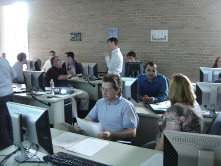Apart from weekly homework activities, there is a final group project, which consists
of the design of a computer-based experiment that can be easily explained to GK-12
students, teachers, and a general audience. To successfully achieving this task,
the students are trained during the course with the use of movie makers, and the
preparation of animated pictures from their molecular simulations. They are also
introduced to the National and State science, math, and technology standards and
grade level expectations. Toward the end of the course, each group presents orally
their projects in the presence of a panel of judges who will evaluate the idea, overall
performance of the group members, and whether their tasks have been achieved properly.
Nanosystems Modeling, supported by my NSF-CAREER Award, was initially designed and
first implemented at LA Tech in Spring 2006 as a technical elective course to junior/senior
students in Chemical Engineering, Nanosystems Engineering, Biological sciences, Biomedical
engineering, Chemistry, and Physics, and a graduate level course to be taken by students
in MS/Molecular Science and Nano-Technology, MS/MicroSystems Engineering, PhD/ENGR,
and PhD/Computational Analysis and Modeling. In Fall 2007, Nanosystems Modeling became
a required course for the Nanosystems Engineering degree in all concentrations, while
continuing an elective to other undergraduate and graduate programs at Louisiana
Tech.
Science and engineering students usually have difficulties visualizing matter due
to its unobservable basis. Using molecular modeling in science and engineering education
provides the basis for individual learning, and the possibility to “visualize” abstract
concepts through computer simulations and graphics, permitting representations and
demonstrations of models of the micro and nano world. This fact inspired me to design
the Nanosystems Modeling course, which consists of a series of lectures about several
molecular modeling techniques, such as Ab Initio, Density Functional Theory, Semi-empirical
methods, Molecular Mechanics, Molecular Dynamics and Monte Carlo, including practical
applications to real nano and bio-systems. At the end of the Nanosystems Modeling
course students are expected to be able to:
i. Identify the right computational techniques for modeling a given system,
ii. Interpret and describe the outputs of the simulations,
iii. Apply different computational techniques on a variety of applications,
iv. Derive and perform computations combining the outputs of several simulations,
v. Design a computer-based experiment using the material covered in class that
can be easily explained to a general audience, and
vi. Evaluate, select, and justify the steps to follow in the design of learning materials
based on molecular simulations.



